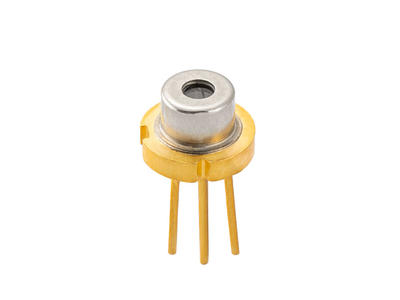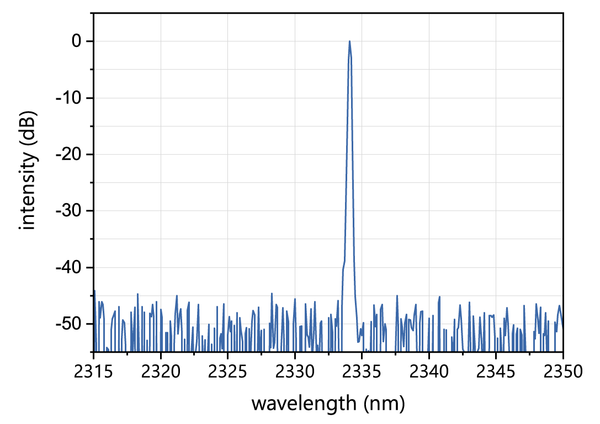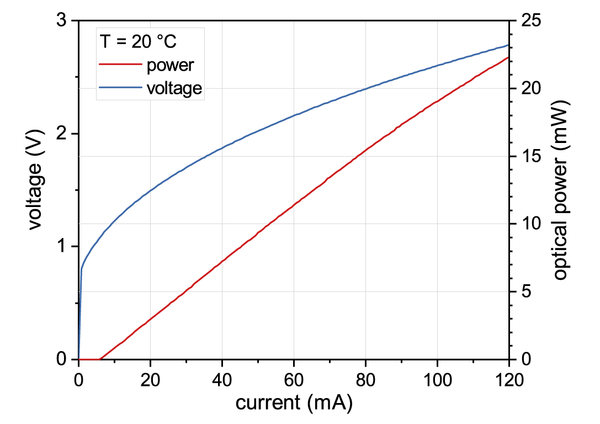

DFB laser diodes at 2330 nm and 2334 nm are used for carbon monoxide detection.
Please have a look at the key features, specifications and applications.
|
parameters
|
symbol
|
unit
|
minimum
|
typical
|
maximum
|
|---|---|---|---|---|---|
|
parameters
operating wavelength (at Top, Iop) |
symbol
λop |
unit
nm |
minimum
|
typical
2330 & 2334 |
maximum
|
|
parameters
optical output power (at λop) |
symbol
Pop |
unit
mW |
minimum
|
typical
6 |
maximum
|
|
parameters
operating current |
symbol
Iop |
unit
mA |
minimum
|
typical
100 |
maximum
|
|
parameters
operating voltage |
symbol
Vop |
unit
V |
minimum
|
typical
2.3 |
maximum
|
|
parameters
threshold current |
symbol
Ith |
unit
mA |
minimum
5 |
typical
10 |
maximum
22 |
|
parameters
side mode suppression ratio |
symbol
SMSR |
unit
dB |
minimum
|
typical
> 35 |
maximum
|
|
parameters
current tuning coefficient |
symbol
CI |
unit
nm / mA |
minimum
0.022 |
typical
0.04 |
maximum
0.07 |
|
parameters
temperature tuning coefficient |
symbol
CT |
unit
nm / K |
minimum
0.19 |
typical
0.20 |
maximum
0.23 |
|
parameters
operating chip temperature |
symbol
Top |
unit
°C |
minimum
+20 |
typical
+30 |
maximum
+45 |
|
parameters
operating case temperature (non-condensing) |
symbol
TC |
unit
°C |
minimum
-20 |
typical
+25 |
maximum
+55 |
|
parameters
storage temperature (non-condensing) |
symbol
TS |
unit
°C |
minimum
-40 |
typical
+20 |
maximum
+80 |







The relatively new research field of breath analysis defines CO concentration in exhaled breath as a biomarker for e. g. respiratory infections and asthma.
[ 63 ]Early fire detection technologies rely on highly sensitive detection of carbon monoxide. Coal-fired power plants, steel mills or biomass deposits use these smoke detectors to increase process and workers safety.
Oxygen control enhances process and cost efficiency of incinerators. Oxidation requires excess air. But too much air cools down the combustion and increases the amount of CO in the flue gas. Real-time and in situ monitoring helps to optimize the oxygen content in combustion processes.
[ 157 , 154 , 3 ]CO is a major element in high temperature processes. Optimizing CO concentration in flue gas increases combustion efficiency. Simultaneously, it reduces greenhouse gas emissions. CO detection at long wavelengths like 2.8 μm and 4.3 μm uses stronger vibrational absorption features than the shorter wavelength ranges. This effect increases the sensitivity of the detector and allows using measurement set ups with short path lengths.
[ 157 , 154 , 124 , 110 , 48 , 35 , 12 , 3 ]nanoplus distributed feedback lasers show outstanding spectral, tuning and electrical properties.

Typical spectrum of a nanoplus 2334 nm distributed feedback laser diode

Typical mode hop free tuning of a nanoplus 2334 nm distributed feedback laser diode

Typical power, current and voltage characteristics of a nanoplus 2334 nm distributed feedback laser diode
nanoplus uses a unique and patented technology for DFB laser manufacturing. We apply a lateral metal grating along the ridge waveguide, which is independent of the material system. Read more about our patented distributed feedback technology.
